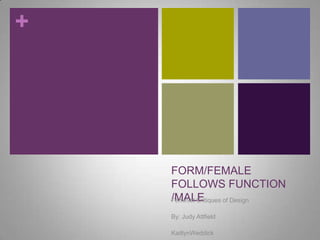
Feminist critiques of design
- 1. FORM/FEMALE FOLLOWS FUNCTION /MALE Feminist Critiques of Design By: Judy Attfield KaitlynWeddick
- 2. Judy Attfield British designer and historian Looked at design from a feminist perspective She and other designers at the time were not trying to restructure society, just simply gain establishment in a predominately male field “If men were to take the lessons of feminism seriously, then the predominantly masculine discourse of design history would be transformed.”
- 3. Judy Attfield Works: Design History or the History of Design A View from the Interior: Women and Design Bringing Modernity Home: Writings on Popular Design and Material Culture (Studies in Design) Journal of Design History Utility Reassessed: The Role of Ethics in the Practice of Design Wild Things: The Material Culture of Everyday Life (Materializing Culture)
- 4. Feminist Critiques of Design Feminist wayatlooking at the division of gender we have in the design field The purpose of this approach should be to discuss women’s concerns in a way so that they do not feel segregated or excluded because of gender Even though there are extremists, a “gendered view” is a practical way of looking at it. It allows movement away from hierarchy and focus on issues beyond gender “There is an urgent need, therefore, to bring to light the work of women pioneers of design in order to provide role models for young women embarking upon design careers who, at present, face unwelcoming, male-dominated enclaves in architecture, engineering, product and industrial design, where all this is thought necessary to meet the needs of women is an equal opportunities policy.” -Judy Attfield
- 5. Feminist Critiques of Design Throughout history, design has always been placed in the male domain. Design has been broken up into gender roles Man: (functional) science, technology, and industrial production Women: (decorative) “soft” form Form comes after function The dominant thinking to this is that the “Machine” comes before the body. With the machine being the male and the body being that of a female. The world sees into the idea that women are cheaper to employ, especially in the part-time, non-unionized workforce, yet we depend on women as the majority of the consuming public in order to function The intention of feminist designer “would be to enhance the quality and usefulness of male design and encourage a position that says designs are not gender-orientated but made for people.”
- 6. “Women Designer” vs Feminist Women Designer: confirms the prejudice that women are inferior designers except for the “feminine” or “soft” areas of design (decorating/ interior design, textiles, and fashion) Based on traditions of art history Problems: places women in a preset, hierarchical framework because they are comparing themselves to the “great” male designers Diminishes women Feminist Critique (Thesis) It makes it possible to look at women designers in a new light See work in the context of the history of the design profession which has constantly held them back It allows feminist to suggest that design is based upon a concern for people, not simply the aesthetics side of it
- 7. Politics Beginning point: women experience the design world differently from men As discussed earlier, the idea that some areas of design are “women’s work” We see a division of labor in all aspects of society, not just design Social norms of gender Society excludes women from science, technology and industry. Example of past (and present) problems: When products are designed that are intended to be used largely by women, they are often designed by men even though if women were to design these object they would have more satisfaction out of using them. Examples: Dishwasher, Washing machines and dryers, dish washers, etc We can see the division of labor in product innovation as well
- 8. Jane Jacobs Death and Life of Great American Cities (1961) One of the most influential books on urban planning and cities Changed the way we look at cities Strong analysis of the 50’s urban renewal policies which had once destroyed communities and urban spaces. By simply adding a female point of view to an architectural review work, the transformation began and it was realized that women had a gain of a valuable insight to how we relate our designed environment to our living experience in them. Quietly influential; not overpowering Open Books: David Owen on Great American Cities http://www.youtube.com/watch?v=5pMASi6FilI
- 10. Pioneer of Modern Movement in architecture
- 11. French architect and designer
- 13. Discussion Questions Do you think that women are still facing this issue of a male dominated field today? Will they in the future? In what ways? Do you think there has been a hierarchy of a “machine aesthetic”? Is fashion in design considered trivial even though we are affected by our environment on many different levels? Do you think it’s better to look at women’s struggle in design through a feminist approach or a “women’s designers” approach? Do you think a gendered view is appropriate as well? Or is simply shifting the unfairness from women to those who struggle with race, class, age, sexuality, religion, occupation, etc? What ways can women designers overcome this?